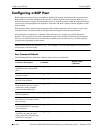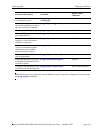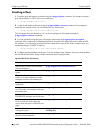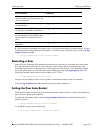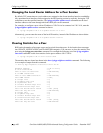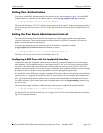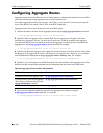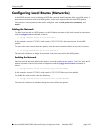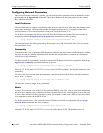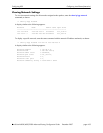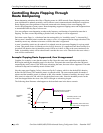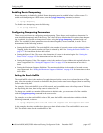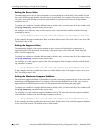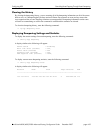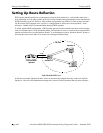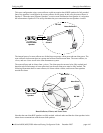
Configuring Local Routes (Networks) Configuring BGP
page 4-34 OmniSwitch 6800/6850/9000 Advanced Routing Configuration Guide December 2007
Configuring Network Parameters
Once a local network is added to a speaker, you can configure three parameters that are attached to routes
generated by the ip bgp network command. These three attributes are the local preference, the commu-
nity, and the route metric.
Local Preference
The local preference is a degree of preference to be given to a specific route when there are multiple routes
to the same destination. The higher the number, the higher the preference. For example, a route with a
local preference of 50 will be used before a route with a local preference of 30.
To set the local preference for the local network, enter the IP address and mask of the local network in
conjunction with the ip bgp network local-preference command and value, as shown:
-> ip bgp network 172.20.2.0 255.255.255.0 local-preference 600
The local preference for routes generated by the network is now 600. The default value is 0 (no network
local preference is set).
Community
Communities are a way of grouping BGP destination addresses that share some common property. Adding
the local network to a specific community indicates that the network shares a common set of properties
with the rest of the community.
To add a network to a community, enter the local network IP address and mask in conjunction with the ip
bgp network community command and name, as shown:
-> ip bgp network 172.20.2.0 255.255.255.0 community 100:200
Network 172.20.2.0, mask 255.255.255.0, is now in the 100:200 community. The default community is no
community.
To remove the local network from the community, enter the local network as above with the community
set to “none”, as shown:
-> ip bgp network 172.20.2.0 255.255.255.0 community none
The network is now no longer in any community.
Metric
A metric for a network is the Multi-Exit Discriminator (MED) value. This value is used when announcing
this network to internal peers; it indicates the best exit point from the AS, assuming there is more than one.
A lower value indicates a more preferred exit point. For example, a route with a MED of 10 is more likely
to be used than a route with an MED of 100.
To set the network metric value, enter the network IP address and mask in conjunction with the ip bgp
network metric command and value, as shown:
-> ip bgp network 172.20.2.0 255.255.255.0 metric 100
Network 172.20.2.0, mask 255.255.255.0, is now set with a metric of 100. The default metric is 0.



